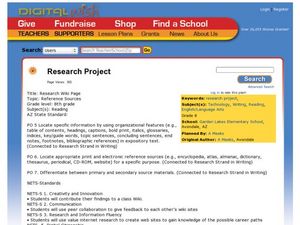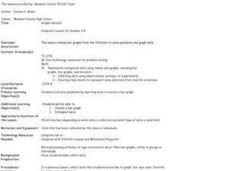Curated OER
What's Wrong?
Students analyze case studies to explore similarities and differences among illnesses. PET images are examined to explore how scientists investigate the changes in the way the brain functions during depression.
Curated OER
Pieces of Mind: Remembering What Matters
Learners watch the program "Pieces of Mind" from PBS and participate in a class discussion about PET scans and their advantages. Students then brainstorm activities a PET scan could be used for.
Curated OER
TECH:Medical Technology - Diagnostic (HST)
Students explore medical terminology used in diagnosis. They explore the dexterity needed by a doctor to perform surgery. Students explore diagnostic methods used today in the medical field, X-rays, Ultrasound, MRI, CT-PET Scans, and...
Curated OER
Memoir - The Gift of Memories
Learners create a memoir or poem about their favorite person or pet. In this favorite person or pet lesson plan, students also scan in pictures to PowerPoint and create a presentation about this person or pet as well.
Curated OER
Regional Differences
Students examine how the brain sends and receives messages by assessing PET scans. They diagram areas of the brain that evaluate various situations. They discover that individuality is due to different responsesnin the brain.
Curated OER
Research Project
Students poll the class regarding their favorite pet and then research that pet using Internet research. They create reports including pictures made on KidPix.
American Museum of Natural History
Keeping a Field Journal
Recording scientific evidence allows for important discoveries and conclusions. A remote learning resource outlines how to create a field journal to record scientific observations. The outline resource includes notation about the...
Curated OER
You Can Change the World
Pupils discuss ways they can help protect the environment. In groups, they examine various types of animals and identify their characteristics, food and habitats are compared. They create a Hyperstudio presentation in which they scan a...
Curated OER
Graphs Abound
Young scholars create a survey for their classmates to collect data on their favorite foods, eye color, pets or other categorical data. They compile the data from the survey in a table and then make a bar graph of each category using a...
Kenan Fellows
An Analytical Chemist, a Biochemist, an Animal Scientist, and an Oncologist Walk into a Lab...No Joke
Oncology presents multiple opportunities for research and the collaboration of many different types of scientists. Scholars divide into groups and research the history of mass spectrometry, polarity/non-polarity,...
University of Kansas
Newspaper in the Classroom
Newspapers aren't only for reading—they're for learning skills, too! A journalism unit provides three lessons each for primary, intermediate, and secondary grades. Lessons include objectives, materials, vocabulary, and procedure, and...
Curated OER
Show 303: New Research into Dyslexia
Students explore the causes of dyslexia. They view CT sans and MRIs to view the brain and how it responds. Students read reports about dyslexia. They discuss the nature of dyslexia, its cause, how to diagnose it, and its permanency.
Curated OER
All About Me - A Spanish Collaboration
Sixth grade students mentor third graders to create an "All About Me" presentation in Spanish. They design three slides in PowerPoint and compare their information to their classmates. At the end of the project, each pair presents their...















